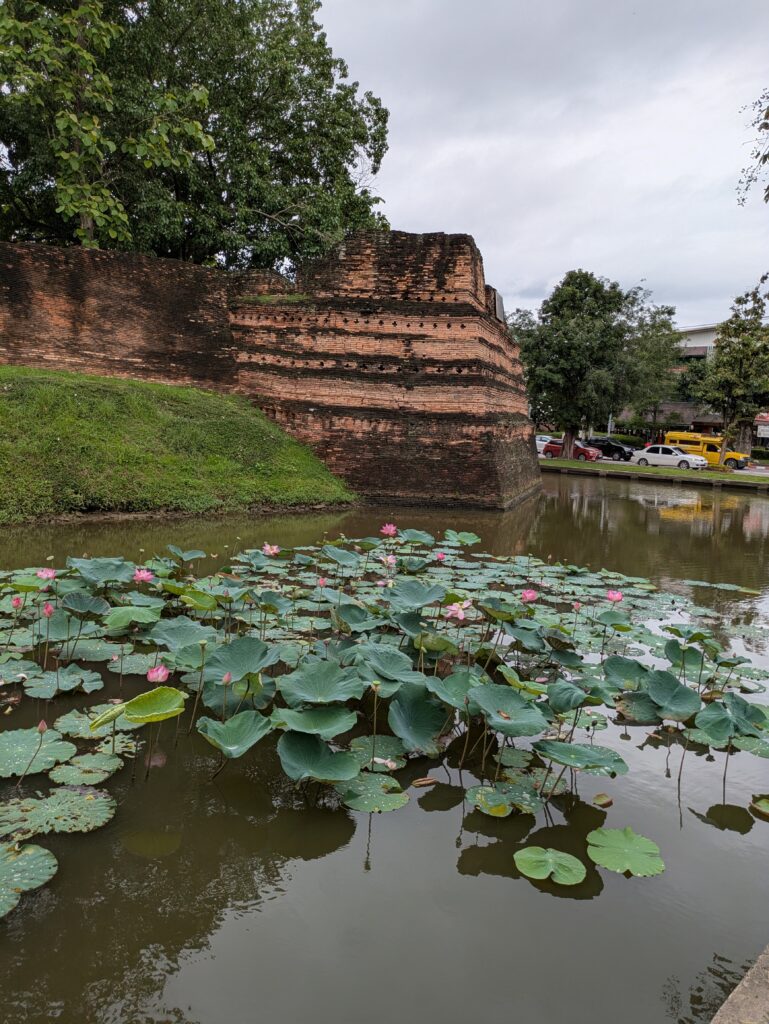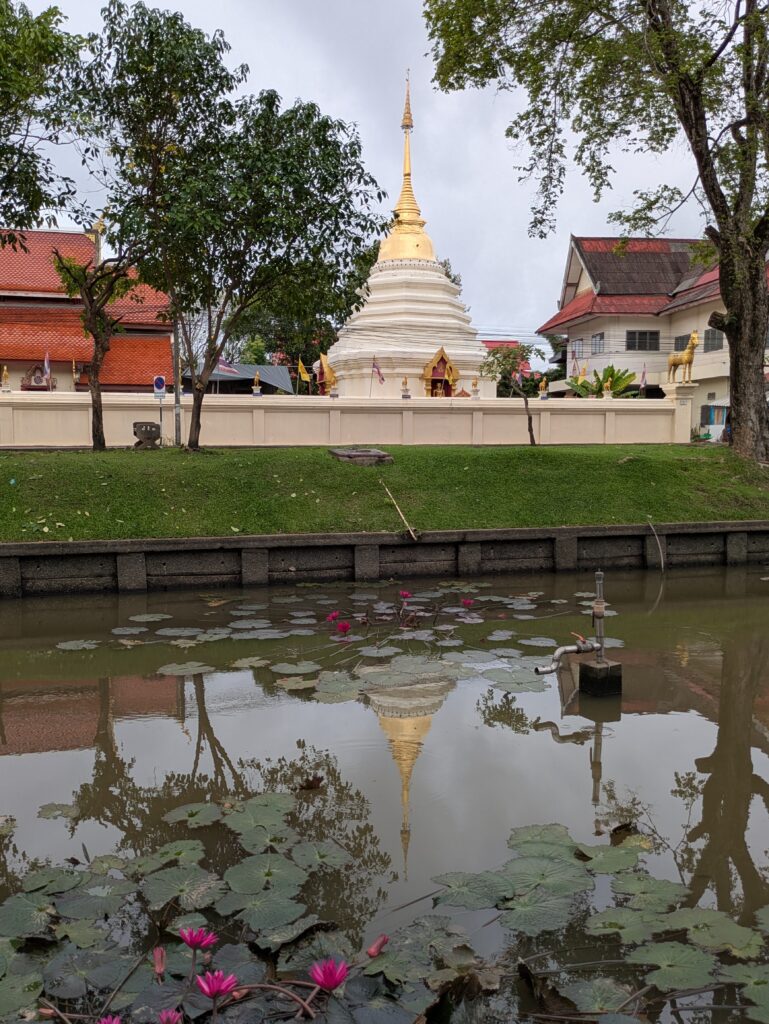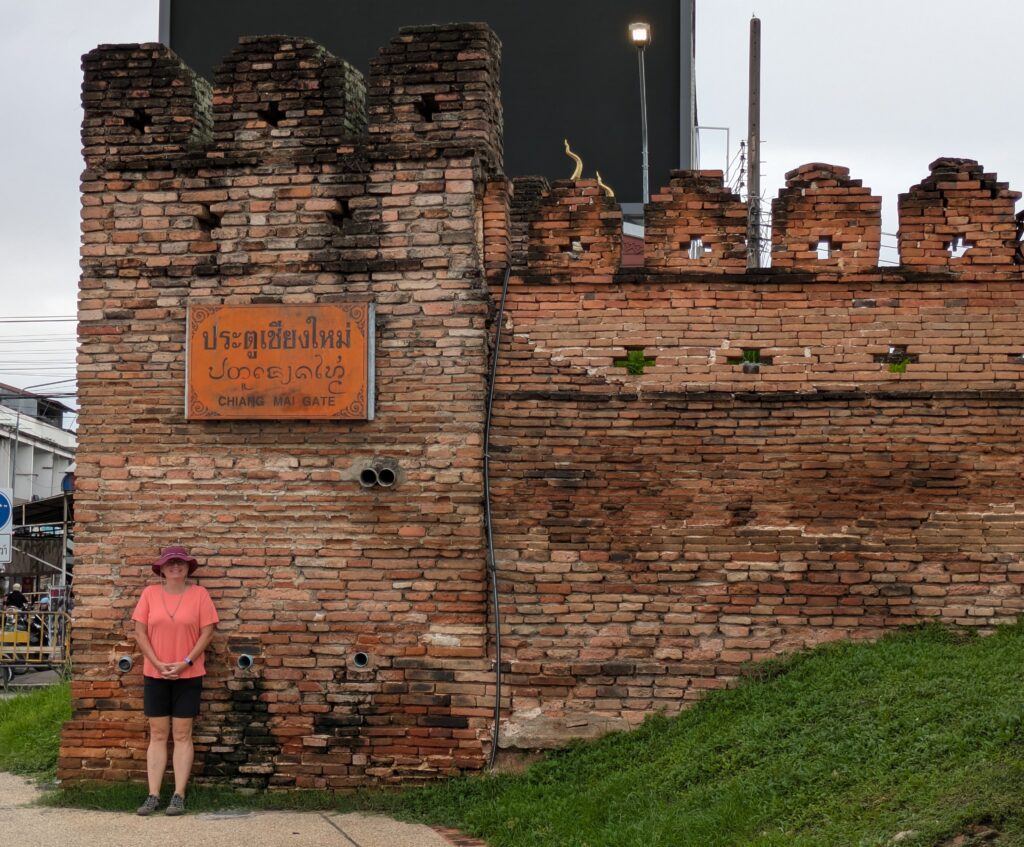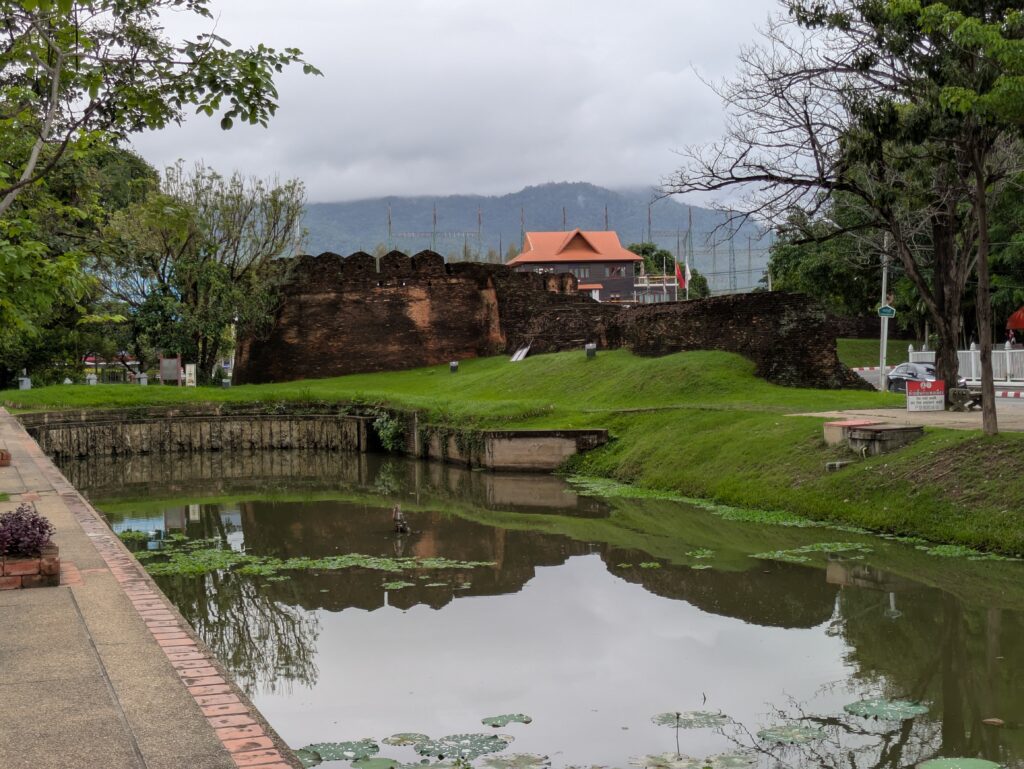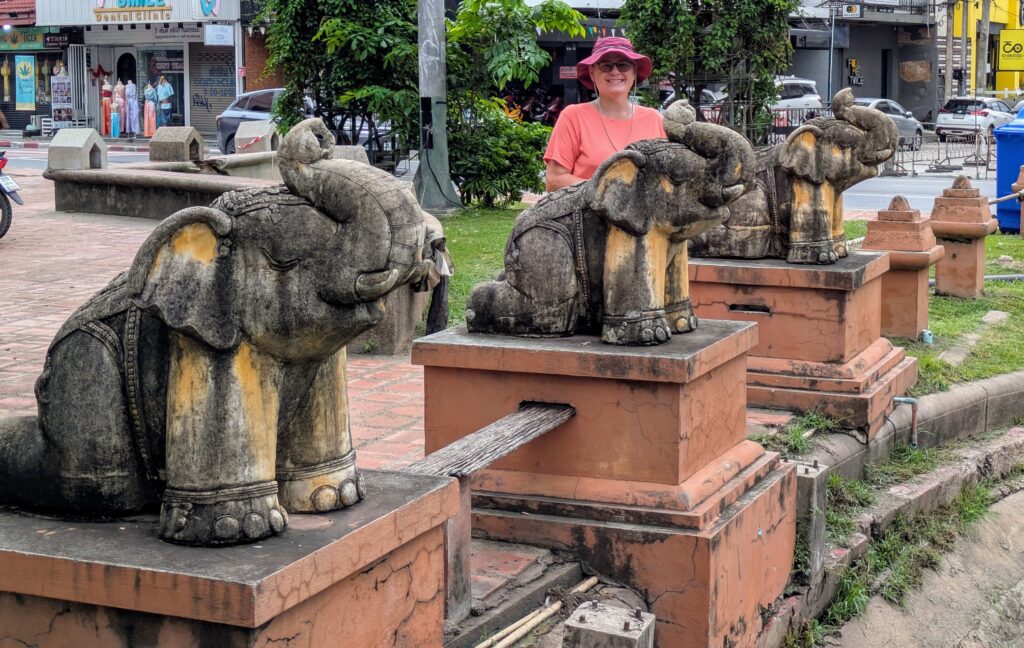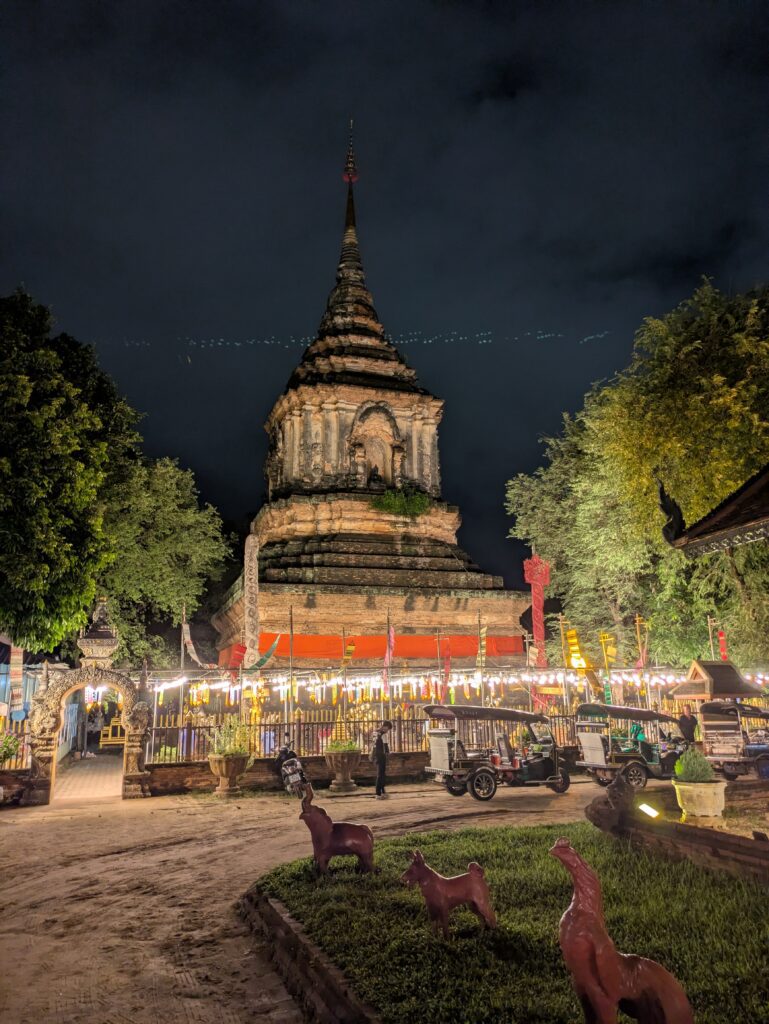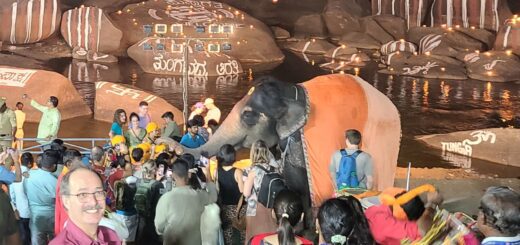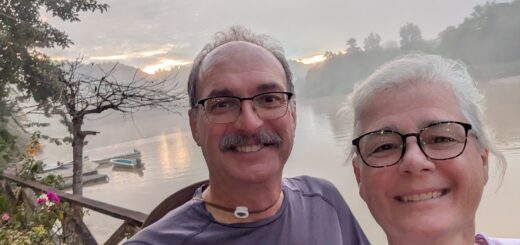Chiang Mai, Thailand #13

May 31,
We both awoke early and set out by 0645. This morning’s weather was cloudy but it should not rain. So we went to Chiang Mai’s old city walls and moat. We parked Baloo just inside the old part of the city, on the counter-clockwise one-way road, but we went out to walk on the clockwise one-way road, as most of the descriptive signs are readable from out there and the moat was better seen from here. (Now, much of the following info was from placards, scanned QR codes, and a helpful article called Walls and Gates of Chiang Mai from Chang Puak Magazine.)
The old city of Chiang Mai was established as the capital site for the Lanna Kingdom around 1296, with it’s walls & moat constructed at this time also. The layout of the where the walls were is mostly a square pattern, with each side being around one mile long (I had conflicting info on how long the walls actually are, most say 1.6 km or one mile). Most of what remains has been reconstructed many times. There are four main corners or “jaeng”– and five brick gates which are where most of the brick fortification remains standing. Along the north are some of the only sections of wall still left.
We started at the Katam Corner, at the Southeast border. The placard states Katam means ‘trap to catch animals’. People had fish traps here as there was a little pond that developed when the moats two channels met and it was rich with fish. Then we walk to the first gate, Chiang Mai Gate. This gate lead people out of town toward Lamphun. Next was the Saen Pung Gate which is the second gate and last on this southern side of old Chiang Mai edge. (The gate was not originally in the plan and added later.) This gate is also called Suan Pung Gate and traditionally the deceased of town were carried out this gate for cremation. Then we walk on along the moat enjoying the water lilies – but not the traffic noise, which was quite busy as it is Saturday. We came to the Southwest bastion, Ku Huang Corner. This Jaeng was named from a bastion administrator or guard, Mun Ruang, whose ashes are buried here. This man guarded Prince Khrua who was kept prisoner here. Its large circular presence, for me, gives the impression of authority.
Now, we walk along the western side, and passed the Suan Dok Gate. There was not an information placard here. But the article listed above, referenced that Suan Dok means ‘door to the flower garden’. This gate lead to a “royal flower garden outside the city walls.” Next, we came to Hua Lin Jaeng, in the Northwest Corner. It’s meaning is ‘head’ (Hua) ‘of an aqueduct’ (Lin); and it is a “brook Huai Kaeo (that) was channeled along an aqueduct, over the moat into the town, and passing through the bastion.” The inflow of water from the creek can be seen streaming into and sustaining the moat still. Surprisingly, the water level is quite shallow here, it actually seems silted up, maybe?
Anyway, we walk on we were on the north side now and see some of the brick walls still standing. This is the prettiest side for me with the walls and the moat & its water lilies and fountains flowing. We pass the two Wats we visited yesterday and another one, Wat Khuan Khama that was reflecting beautifully in the moat water – gorgeous! Then we came up to the “busy” gate and the one considered the most important, Chang Puak Gate. “It was used by royalty on state occasions… Chang Puak means the ‘white elephant’, in honor of two servants who saved King Saen Muang Ma’s life.” There are Instagram elephants outside of this gate, but they are pink, blue and yellow… not white!🤣😂
Next we walk up to the four and last bastion, Si Phum Jaeng, in the Northeast corner. The only info I can find is the name Si Phum means ‘the Splendor of the City.’ Jeff and I certainly feel it’s the most stunning… With it’s alternating dark (& moss covered) bricks to red colored ones flowing in a ripple pattern. We then completed our venture walking along the eastern wall and going to the fifth and last gate, Tha Pae Gate. Tha means ‘harbour’ and Pae means ‘floating house’. This gate ‘connected with the Ping River where rafts and floating houses were’ further away lay the harbour that was the trade center for Chiang Mai.
Whew – what fun that was!! We were hungry now, though!! It was time for… breakfast!?! Crazy, busy morning – it was only 0900! We first went to a local coffee roastery. I tried their coffee, but it’s not what I want daily. So I finished my coffee, then we left on Baloo. We went to a place we had eaten at in 2011! It’s Gekko Garden. I remembered it as soon as we went into the covered outdoor eating area! We had a Corned Beef Hash n’ Eggs with toast plate; and a Canadian Bacon, Eggs, and Hash Browns with toast plate. I had a pineapple juice and Jeff an orange. Super great breakfast. This place caters to Ex-pats – the menu is filled with good old favs. It cost us 368 THB ($11.20).
Now we went back to our place and chilled out, literally. I blogged and Jeff read. No lunch needed, but by 1730 we were hungry. We went back out to a weekly Saturday street scene, checking a lot of it out. We settled on the food court area with the opening sign reading, ‘Seat/Food Handmade Ideamarket.’😂 We walked all around and decided on four different stall’s food. They were Indian Food- one Veggie Samosa each, with two great sauces, equaling 90 THB ($2.74); Fish Cake- one small bowl of Fish Cakes (balls with deep fried Holy Basil) for 40 THB ($1.22); a sausage booth (no name on the stall)- one Sour Thai Sausage, 20 THB ($0.61); and Pad Thai- a Veggie Pad Thai for 50 THB ($1.52). Then we decided on a dessert, getting a Coconut Ice Cream from ‘Homemade’ stall, which costs another 50 THB ($1.52). Total for all the food was $7.61. We finished just in time to boogie back before the rain. Stayed at our place until 2000 then went back out to see around Chiang Mai’s walls and the Wats from yesterday at night. A quick zip around on Baloo – it was lit up so well, dazzling.
What fantastic day!!!
